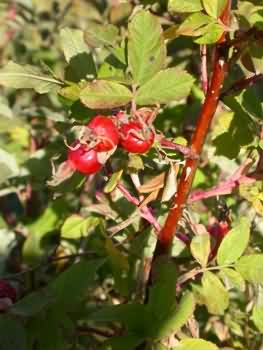Relatives
Rosa majalis Herrm. - May.s rose
Taxonomic position.
Family Rosaceae Juss. genus Rosa L.Synonyms.
Rosa amblyotis C.A.Mey., R. cinnamomea auct. non L., R. jacutica Juz.Morphology and biology.
Deciduous shrub, up to 1.5-2 m high, having thin, naked, glossy, reddish shoots, covered with small and crooked prickles located for the most part near the base of leaves and young shoots. Numerous straight and thin prickles and bristles may be found in the lower part of the branches. Leaves are alternate, compound, imparipinnate, 5-9 cm long, consisting of 5-7 (9) leaflets. Leaflets are 1.5-5 cm long, oblong-elliptic, sharp, glandular-serrulate or denticulate along the edges, on both sides varying from naked to pubescent, without punctate glandules. Pedicels are 0.5-3 cm long, varying from naked to glandular-pubescent. Sepals are 1-3.3 cm long, smooth-edged, from naked to pubescent on the outside, frequently covered with cauliform glandules. Flowers are single or grouped by 3-5. Corollas are pink, 3-6 cm in diameter. The fruit is a multi-nut inside an effuse hypanthium, which becomes fleshy and forms the cover of a pseudocarp. Fruits are 10-20 mm long, red or orange, globular or ovoid, naked, pulpy, with residual ascendant sepals. The species is entomophilous. It is ornito- and zoochore. It is propagated by seed and summer cuttings. Seeds need to be stratified for 6-7 months at 3-5 degrees Centigrade. Blossoms in May-June; fruits ripen in late August-September. Chromosome number: 2n=14, 28.Distribution.
Scandinavia, Central and Eastern Europe (except the littoral regions of the Black Sea), Crimea, Caucasus (Ante-Caucasus), Western Siberia (except the Far North), Eastern Siberia (the basin of upper and middle course of the Yenisey, basin of the Angara, southern coastal areas of Baikal, north-western Trans-Baikal territory), northern Kazakhstan, Tarbagatai, Mongolia.Ecology.
This species is a mesophyte. It is drought-resistant and tolerates shade. It grows either as single plants or in small groups in the undergrowth of thinned forests, on forest edges and glades, along river banks and on damp meadows. Often dominates in the brushwood inhabiting flood land areas. It does not grow too high in the mountains, occurring mostly in the foothills.Utilization and economic value.
This species is used as a food, melliferous, medicinal and ornamental plant. Decoction of boiled fruit yields yellow dye. It is recommended for single-plant or group plantings in landscaping design.Reference citations:
Koropachinskiy I.Yu., Vstovskaya T.N. 2002. Woody plants of the Asian part of Russia. Novosibirsk: Publishing House of SB RAS, Branch "Geo". 359-360 pp. (In Russian)Sokolov S.I., Svjaseva O.A., Kubli V.A. 1980. Areas of distribution of trees and shrubs in the USSR. V. 2. Leningrad: Nauka. 94 p. (In Russian)
Yuzepchuk, S.V. 1941. Rose (wild rose)-Rosa L. Flora of the USSR. V. 10. Moscow-Leningrad: Publishing House of the USSR Academy of Sciences. 454-455 p. (In Russian)


